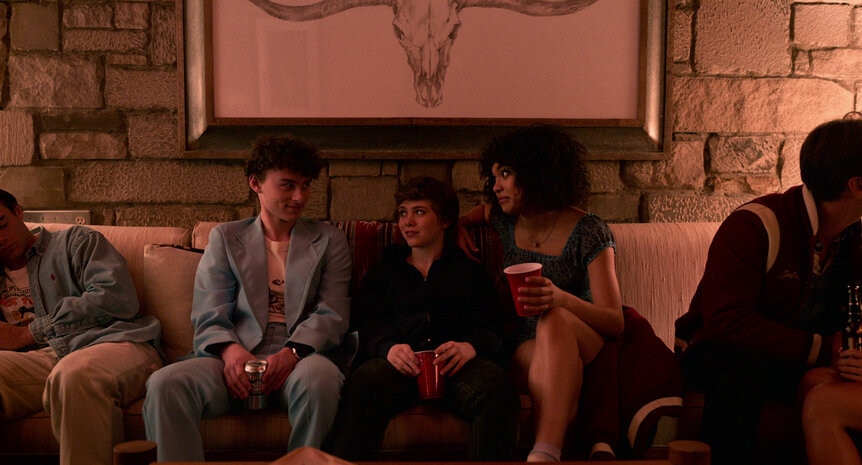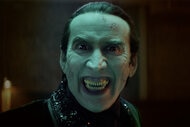Create a free profile to get unlimited access to exclusive videos, sweepstakes, and more!
How I Am Not Okay With This updates the teen girl with powers narrative

The image of a teenage girl covered in blood in a gymnasium decorated for senior prom is instantly recognizable. Even if you are not a fan of horror, the fate of Carrie and her classmates is something most pop culture aficionados are at least aware of. The Stephen King novel was first adapted in 1976, featuring Sissy Spacek in the titular role — its inferior 2013 remake also ended with a pig's blood shower — unleashing a powerful puberty allegory and tale of high school vengeance.
Telekinetic powers aren't only reserved for female characters, but there is a prevalence of this ability in young girls — from Matilda (Mara Wilson) to Eleven (Millie Bobby Brown) in Stranger Things. The Exorcist saw Regan's (Linda Blair) moving objects with her mind as a result of her demon-fueled talents. Joining these impressive ranks is I Am Not Okay With This protagonist Sydney Novak (Sophia Lillis), who is dealing with grief, anxiety, and her sexuality — as well as every other teen predicament. At 17, she is on the precipice of adulthood, and her body is manifesting its rage in an unusual and dangerous way.
Spoilers for I Am Not Okay With This ahead.
Carrie's climax features a teenage girl drenched in blood, which is how I Am Not Okay With This opens. Sydney's crimson-streaked face is teased throughout the first six episodes before the finale reveals why her homecoming frock is beyond salvaging. The familiarity of this visual suggests this story is going to be one we have seen countless times, depicting torment and vengeance with a conclusion tied to her special abilities. And while this is not not true, the decorated gymnasium scene doesn't play out quite as you might imagine.
Unlike Carrie's, Syd's mom doesn't think she has the devil inside her when she starts her period. Nevertheless, this relationship is fraught; a lack of communication since her father died by suicide is the cause. Fundamentally this home is still full of love, but the question mark that hangs over why her father did it (including his lack of a note) has driven a wedge between mother and daughter. Syd's grief is in a permanent rage cycle, which in turn has led to constant bickering.
Syd isn't alone in her pain; her little brother Liam (Aidan Wojtak-Hissong) provides distraction and support. This dynamic helps set I Am Not Okay With This apart from the tales of isolated teens that came before it, even if it isn't without its own conflict. Sydney's attempt to protect her brother from his middle school bully only makes matters worse. Puberty is hard on everyone, but it is particularly humiliating when an older sister steps in; even if she doesn't use her powers, she still puts a target on Liam's back.
In Stranger Things, Eleven wields her telekinesis against the bullies of Hawkins Middle School with great effect. Unlike Sydney, her life began as an experiment; it is only when she escapes the facility that she learns what friendship and family are. Because she grew up in a controlled setting, her power has always been harnessed under a scientific umbrella, and she has a relatively good grasp of how to use it. This isn't a telekinesis tap that was turned on when she hit puberty or got her first crush; rather it has been part of her since birth. Sydney does not have the advantage of a mentor — no matter how unethical what happened to Eleven is, she always had a guide — so she is in this scary mess alone. Her trauma has turned inward, and when the unthinkable begins to happen, she tries to hide her new skill set.
Grief and displaced rage are not the only emotions Sydney is experiencing; her sexuality is also leading to doubt and confusion. One of the first signs she has powers is when she makes her best friend's new boyfriend's nose bleed. Sure, Bradley Lewis (Richard Ellis) is your typical jock douche, but her anger is laced with an undertone of jealousy she can't quite name. It is only after she sleeps with Stanley Barber (Wyatt Oleff) that she figures out why Brad is causing so much consternation. After her stoned glow has worn off, she realizes she doesn't like Stan "like that." And when she dances with Dina to Rick Springfield's "Jessie's Girl" at a high school party, those feelings finally become clear.
Fleeing the party after Dina rejects her advances — thankfully, Dina doesn't turn on her BFF, as these narratives often play out — Sydney unleashes her humiliation via a scream into the woods. Some very innocent trees get knocked down as a result of her newfound power. Add this to the long list of other casualties in Season 1, including her bedroom wall, groceries, the bowling alley decor, a sign, Liam's hedgehog, and the school library shelving.
This sexual awakening coupled with her shame at making a move on Dina could isolate Sydney further, but there is a witness to her tree destruction. Taking a turn toward the meta, Stanley uses his years of reading comic books to help his friend through this time of crisis. They figure out what causes her to lose control in Episode 4: "It almost always comes out when I am angry. Or embarrassed. Or scared." It is far more than "just puberty," as Sydney tried to tell herself when these incidents began, even if it is a symbolic nod to the melting pot of emotions that occur during this tumultuous period.
Stephen King once spoke of the allegorical connotations on display in Carrie (which he explained in Danse Macabre), saying that they were a reaction to how second-wave feminism was a concern in the early '70s, "largely about how women find their own channels of power, but also what men fear about women and women's sexuality." However, Carol J. Clover in Men, Women, and Chain Saws notes there is conflict within King's statements, as he likens Carrie's revenge to any student who has been at the end of a high school bully's torment. This universal identification switches the perspective away from the feminist subtext.
In The Exorcist, Regan's state reflects a country that is still concerned about how divorce will impact the notion of family values. It is no coincidence her possession coincides with puberty; feminine desire is a dangerous concept and one the devil will utilize in the most overt and brutal manner if a household lacks a father figure.
Unlike Carrie's targeted revenge during the senior prom climax and Regan's demonic punishment for losing her girlhood, I Am Not Okay With This subverts the telekinesis tropes by making this an inherited power from her father, rather than a result of her dad's absence. There are still plenty of unanswered questions, but rather than isolating herself further, Sydney is stabilized by her family and friendships. Walls that have been erected are broken down when her mom tells her about the familiar-sounding issues that plagued her father.
Of course, the homecoming dance is cut short when Sydney's powers cause Brad's head to explode, but she doesn't go full Carrie. It isn't the whole school bullying her, but it is the aggrieved ex of her BFF with a plan to humiliate her via the diary he stole.
Before he can reveal her secret to the world, her body goes into self-protection mode; being outed in such a public (and homophobic) manner takes away Sydney's control. In the moments before Brad's public reading of her most private thoughts, Dina has told her best friend that she also has feelings for her. The pivot from an emotional high to her "freak" status almost being announced at the high school social event of the year unleashes the most dangerous version of these abilities.
Setting up the larger story for a second season ensures there are plenty of directions Sydney's story could go in. The influences of other teen girls with uncontrollable telekinetic abilities provide the foundation for I Am Not Okay With This, but grounding the emotion in her bonds with her friends and family is where the true power of this adaptation lies.

































